Traditionally, sweet and sour pork ribs are made by frying them until they turn golden and crispy, followed by braising them in a sticky sweet and sour sauce, resulting in a delightful combination of chewy texture and crunchy caramelized surface, bursting with flavor.
The ingredients for this classic Chinese cuisine include pork ribs, sugar, vinegar, light and dark soy sauce, garlic, ginger, and spring onions. Although you can use any type of ribs, the authentic ways usually use small single riblets measuring about 2 inches (5 cm) in length.
Note: This post may contain affiliate links. Please read my privacy policy for more info. I may receive commissions for purchases made through links in this post. As an Amazon Associate, I earn from qualifying purchases.
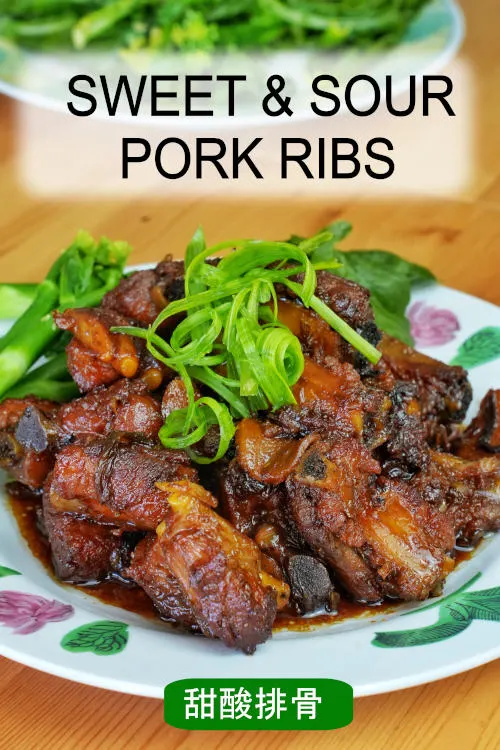
1. Variations of sweet and sour pork ribs
There are various methods to prepare sweet and sour pork ribs. Some traditional recipes involve a cooking technique called Chao Tang Se/炒糖色, which entails melting sugar in water until it becomes sticky and amber. The syrup is then used to coat the meat. This technique requires careful control to avoid burning the sugar. Other recipes suggest marinating the ribs and briefly deep-frying them in hot oil to achieve a crispy outer layer and tender interior. In a simplified home version, the ribs can just be simmered with a sauce until it thickens, and skip the above steps. Lastly, Hawaiian-style sweet and sour spare pork ribs incorporate flour, soy sauce, vinegar, pineapple juice, brown sugar, and garlic.
Sweet and sour pork ribs are typically served as appetizers in Chinese and Taiwanese restaurants.
2. My sweet and sour pork ribs recipe
My sweet and sour pork rib recipe is based on my regular cooking method, which has elements from all the abovementioned variations. The main difference in my approach is that I bake the ribs at a temperature of 230°C/450°F for thirty minutes until they turn golden brown. Baking yields a similar effect as deep-frying to enhance the flavor through the Millard reaction. Afterward, I coat the pork ribs with the caramel, then simmer them with sugar and vinegar until soft and tender.
I prepare a sugar syrup using oil, water, and rock sugar to make a caramel to coat the pork ribs. This achieves the familiar glossy and deep-colored pork ribs served in Chinese restaurants.
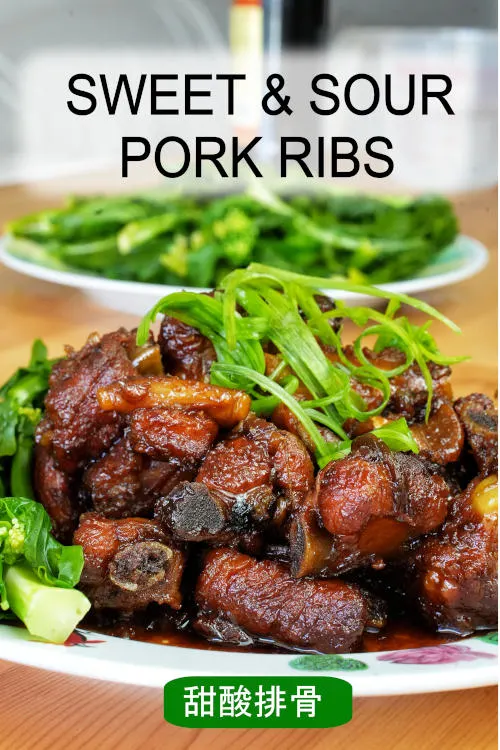
3. How to cook the sweet and sour pork ribs
Here is a step-by-step guide on preparing my favorite sweet and sour pork ribs.
a. Clean and blanch the pork ribs
Since I didn’t have a butcher knife, I requested my butcher cut the pork ribs into bite-sized pieces.
Now, let’s address the question of blanching pork ribs as a pretreatment, as there are varying opinions.
It ultimately depends on your preference. Blanching the pork ribs, especially with rice wine, spring onions, and ginger, is a common method to remove impurities and any gamey smell from the ribs. Some home cooks don’t mind pork’s natural smell and skip this step. If the ribs are fresh and don’t have any undesirable smell, I simply skip blanching and wash them thoroughly with water to remove any bone debris and blood, and it is good to proceed to the next step.
If you want to blanch the pork ribs, place them in a pot of boiling water along with some cooking wine, a few slices of ginger, and a stalk of spring onion. Let them blanch for two to three minutes, skimming off any scum that rises to the surface. Then, drain the pork ribs in a colander and pat them dry with a cloth.
b. Deep-fried or bake the pork ribs
To enhance the final dish’s flavor, you can either deep-fry or bake the pork ribs before braising them.
Deep-frying is a common method used in restaurants, but it does require a larger amount of oil and leaves behind used oil, which can be wasteful. To take a different approach, I decided to bake the ribs at a high temperature (230°C/450°F) until they turned golden brown. To achieve this, I pat the pork ribs dry and lightly coat them with a small amount of oil. Then I arrange them on a baking rack in the middle position. The baking time will vary depending on the size of the ribs, but generally, it takes at least thirty minutes to turn golden brown.
c. Make a caramel to color the pork ribs
The secret ingredient is caramel if you’ve ever wondered how restaurants achieve that stunning glossy surface and beautiful dark brown coating on their pork ribs.
To start, heat some oil in a pan and add the sugar. You must keep the heat low as high heat can burn the sugar quickly. After the sugar melts, add a little water to the melted sugar. Be cautious, as there may be some splattering.
Next, it’s time to mix the caramel syrup with the cooked ribs over medium heat for a minute or two until they are fully coated with the caramel.
Note: The caramel will make the pork ribs more glossy if you use rock sugar. However, you can substitute it with white sugar if you don’t have rock sugar.
d. Braise the pork until tender
Now, let’s add the wine, vinegar, light soy sauce, sugar, and the other seasonings as indicated in the recipe. To enhance the flavor, I recommend including a few cloves of garlic that complement the flavor of vinegar.
It’s preferable to use traditional Zhenjiang vinegar (a type of Chinese black vinegar), widely used in Chinese cooking. While other types of vinegar can still yield good results, it’s best to avoid using white vinegar as it may result in a less desirable flavor.
Let the pork ribs simmer for approximately 1-2 hours or until tender. Meanwhile, ensure enough water is in the pot to cover the pork ribs. Periodically check the water level and add a small amount if necessary.
Do not add water in the final thirty minutes of cooking to allow the liquid to naturally reduce into a thick, flavorful sauce that will coat the pork ribs.
Additionally, perform a taste test to determine if any adjustments are needed to balance the sweetness and sourness of the dish. Some sweet and sour pork ribs recipes include ketchup to achieve the desired sweet and sour flavor.
Alternate method
For an alternative cooking method, transfer the pork ribs to a slow cooker and let them simmer until they become soft and tender. Since slow cookers typically require less water, avoid adding excessive water for simmering the ribs. We aim to reduce the liquid and create a thick and sticky sauce.
There’s no need to use cornstarch to thicken the gravy since the bone collagen acts as a thickening agent, giving the sauce a silky smooth and glossy texture.
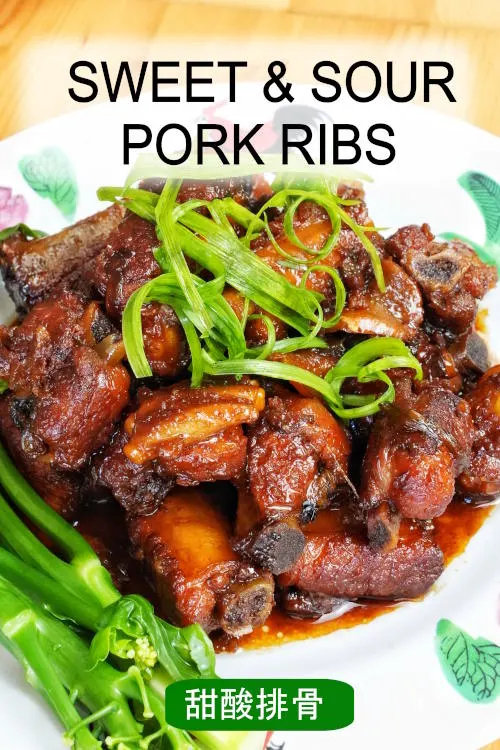
4. How to serve the sweet and sour ribs
The easiest way to present the pork ribs is by arranging them on a plate alongside some vegetables. To add a finishing touch, sprinkle toasted white sesame seeds and spring onions (green onions) as garnish.
These pork ribs can be enjoyed as an appetizer or a main course. Here are a few additional serving suggestions:
- Prepare a refreshing coleslaw as a side dish.
- Create a pasta salad to accompany the ribs.
- Serve them with steamed rice, a popular choice in our family.
- Make stir-fried or roasted vegetables, such as broccoli, carrots, and bell peppers, as they beautifully complement the rich flavors of the ribs.
5. Other similar Chinese recipes on this food blog
If you enjoyed this Chinese pork ribs recipe, I have more similar recipes that I would like to recommend to you.
- Another Chinese pork ribs recipe involves the use of star anise and cinnamon. The resulting flavor is unique, differing from the sweet and sour variations.
- Try this authentic Malaysian Chinese pork chop, the “Pork Ribs King.” The pork ribs are marinated, deep-fried to perfection, and generously coated in a delectable sweet and sour sauce.
- If you’re looking for a quick and easy option, I recommend this honey garlic pork chop recipe. It is one of the most popular recipes on this food blog.
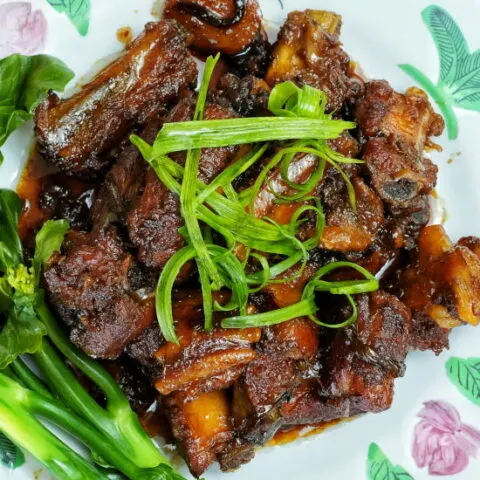
Sweet and sour pork ribs
A tested recipe for sweet and sour pork ribs. A delightful Chinese classic you can easily make at home.
Ingredients
Ingredients A
- 1.5 pound pork ribs
- 4 slices ginger
- 1 stalk of spring onions, cut into sections
- 1 tbsp rice wine
Ingredients B
- 50g rock sugar
- 2 tbsp cooking oil
- 1/4 cup water
Ingredients C
- 2 tbsp light soy sauce
- 2 tbsp Shaoxing wine
- 3 cloves garlic
- 5 thin slices of ginger
- 2 stalks of spring onions, cut into sections
- 3 tbsps Zhengjiang vinegar
- 1 tbsp sugar
- 1 tsp salt
To garnish
- Spring onions for garnishing
Instructions
Clean and blanch the pork ribs (Ingredients A)
- Place the pork ribs in a pot of boiling water along with cooking wine, a few slices of ginger, and a stalk of spring onions. Let them blanch for two to three minutes, skimming off any scum that rises to the surface. Then, drain the pork ribs in a colander and pat them dry with a cloth.
Bake the pork ribs
- Coat the pork ribs with a small amount of oil
- Arrange them on the baking rack.
- Bake the ribs at a high temperature (230°C/450°F) until golden brown. Generally, it takes at least thirty minutes to turn golden brown.
Make a caramel to color the pork ribs (Ingredients B)
- Heat some oil in a pan and add the rock sugar. Keep the heat low as it burns quickly. After the sugar melts, add a little water to the melted sugar. Be cautious, as there may be some splattering.
- Mix the caramel syrup with the cooked ribs over medium heat for a minute or until fully coated with the caramel.
Braise the pork until tender
- Now, let's add the garlic cloves, the remaining sugar, vinegar, light soy sauce, and the other seasonings as indicated in Ingredients C.
- Add enough water to cover the pork ribs.
- Simmer for approximately two hours. Open the lid at least once in the process to mix it to ensure even cooking.
- Transfer the pork ribs to the plate to serve when the liquid is reduced to a thick gravy.
Recommended Products
As an Amazon Associate and member of other affiliate programs, I earn from qualifying purchases.
Nutrition Information:
Yield: 3 Serving Size: 1Amount Per Serving: Calories: 1081Total Fat: 80gSaturated Fat: 22gTrans Fat: 1gUnsaturated Fat: 40gCholesterol: 238mgSodium: 1723mgCarbohydrates: 39gFiber: 2gSugar: 23gProtein: 50g
This data was provided and calculated by Nutritionix on 7/15/2023



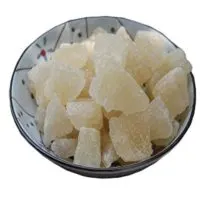
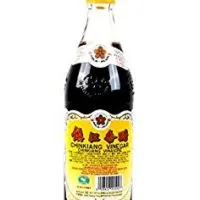
Sweet and Sour Sauce for Pork Ribs: A Delightful Culinary Experience
Friday 12th of July 2024
[…] Last updated: July 16, 2023. Chinese, pork. Traditionally, sweet and sour pork ribs are made by frying them until they turn golden and crispy, Taste Of Asian Food […]
Jessie keng
Thursday 4th of January 2024
You mentioned about cooking this recipe in pressure cooker.pl let me know how toprepare it and the various stages of cooking.thanks
KP Kwan
Sunday 7th of January 2024
I have yet to write a specific recipe for using a multi-cooker for sweet and sour pork.
However, you can refer to another recipe I just published; it involves using multicolor for pressure-cooking and other processes.
Mya
Monday 11th of September 2023
Hello. Can I substitute the rock sugar with just regular sugar?
KP Kwan
Friday 15th of September 2023
Yes, the difference is marginal.
Mylene
Sunday 16th of July 2023
Thank for your recipe i will try and make it looks great thank you
Irene van Lawick
Sunday 16th of July 2023
What can you use instead of garlic as I am garlic intolerant and also I am allergic to ginger as I would like to cook this recipe
KP Kwan
Thursday 20th of July 2023
Losing the flavors of ginger and garlic can be disappointing, but considering your allergy, omitting them is the best option. Even without ginger and garlic, it will still be a tasty creation. Happy cooking.